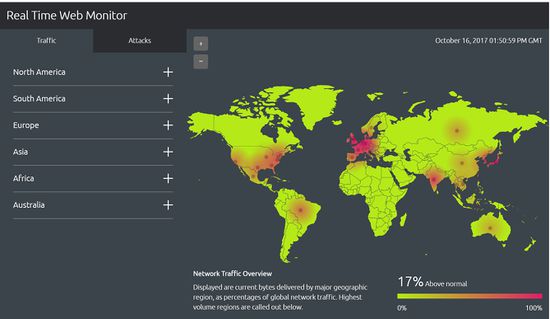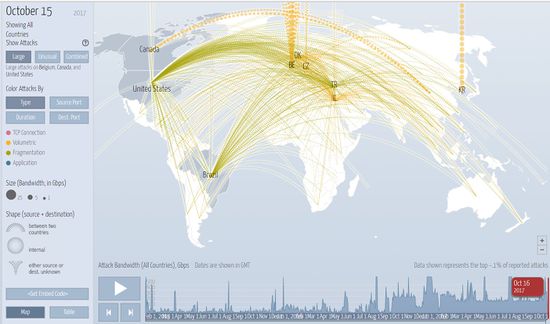Difference between revisions of "1718t1is428T12"
| Line 23: | Line 23: | ||
<br/> | <br/> | ||
| − | ==<div style="background: #F3BE32; padding-top: 20px; padding-bottom: 20px; line-height: 0.3em; text-indent: 15px; font-size:18px; font-family:Trebuchet MS; letter-spacing: 1px;"><font color= #1D1D1D> | + | ==<div style="background: #F3BE32; padding-top: 20px; padding-bottom: 20px; line-height: 0.3em; text-indent: 15px; font-size:18px; font-family:Trebuchet MS; letter-spacing: 1px;"><font color= #1D1D1D>Motivation</font></div>== |
| − | |||
In data analytics and visualization, there are unique challenges faced in the security realm as compared to conventional Business Intelligence analytics; rare events (i.e. attacks) within massive volumes of data need to be detected. Organizations commonly use Security Information and Event Management software solutions to gather security events from various systems and logs, by deploying real-time alert tools optimized to do event-driven signature matching for a subset of the overall gathered data. As attacks are more sophisticated these days, threats are more difficult to detect with signature-based systems. | In data analytics and visualization, there are unique challenges faced in the security realm as compared to conventional Business Intelligence analytics; rare events (i.e. attacks) within massive volumes of data need to be detected. Organizations commonly use Security Information and Event Management software solutions to gather security events from various systems and logs, by deploying real-time alert tools optimized to do event-driven signature matching for a subset of the overall gathered data. As attacks are more sophisticated these days, threats are more difficult to detect with signature-based systems. | ||
| + | ==<div style="background: #F3BE32; padding-top: 20px; padding-bottom: 20px; line-height: 0.3em; text-indent: 15px; font-size:18px; font-family:Trebuchet MS; letter-spacing: 1px;"><font color= #1D1D1D>Objective</font></div>== | ||
The aim of the project is to help organizations identify high-level security threats and attacks by analyzing large amounts of security data (i.e. event logs) we have collected, such that security analysts are able to deal with such threats and attacks with the findings without being required to have strong data science proficiency. | The aim of the project is to help organizations identify high-level security threats and attacks by analyzing large amounts of security data (i.e. event logs) we have collected, such that security analysts are able to deal with such threats and attacks with the findings without being required to have strong data science proficiency. | ||
| − | |||
==<div style="background: #F3BE32; padding-top: 20px; padding-bottom: 20px; line-height: 0.3em; text-indent: 15px; font-size:18px; font-family:Trebuchet MS; letter-spacing: 1px;"><font color= #1D1D1D>Background Survey of Related Works</font></div>== | ==<div style="background: #F3BE32; padding-top: 20px; padding-bottom: 20px; line-height: 0.3em; text-indent: 15px; font-size:18px; font-family:Trebuchet MS; letter-spacing: 1px;"><font color= #1D1D1D>Background Survey of Related Works</font></div>== | ||
Revision as of 03:05, 14 November 2017
Contents
Motivation
In data analytics and visualization, there are unique challenges faced in the security realm as compared to conventional Business Intelligence analytics; rare events (i.e. attacks) within massive volumes of data need to be detected. Organizations commonly use Security Information and Event Management software solutions to gather security events from various systems and logs, by deploying real-time alert tools optimized to do event-driven signature matching for a subset of the overall gathered data. As attacks are more sophisticated these days, threats are more difficult to detect with signature-based systems.
Objective
The aim of the project is to help organizations identify high-level security threats and attacks by analyzing large amounts of security data (i.e. event logs) we have collected, such that security analysts are able to deal with such threats and attacks with the findings without being required to have strong data science proficiency.
Background Survey of Related Works
| Visualizations | Explaination |
|---|---|
|
|
Digital Attack Map is a live data visualization of DDoS attacks around the globe, built through a collaboration between Google Ideas and Arbor Networks. The tool surfaces anonymous attack traffic data to let users explore historic trends and find reports of outages happening on a given day. |
|
|
Global botnet threat activity map by Trend Micro shows the monitored malicious network activity to identify command-and-control servers. It enables security analyst to identify which computers are being attack how many often over the past 2 weeks. |
|
|
Global Internet conditions map by Akamai. With this real-time data they identify the global regions target of the greatest web attack traffic, cities with the slowest web connections (latency) and geographic areas with the most web traffic (traffic density). |
Tools / Libraries
- Tableau
- Github
- Microsoft Excel
- Adobe Creative Suites
- Sketch
- Javascript: sigma.js, vis.js, three.js, D3.js
- Python
Technical Challenges
| Key Technical Challenges | Detailed Description | Proposed Solution |
|---|---|---|
|
D3.js is a JavaScript library for producing dynamic, interactive data visualizations in web browsers. |
| |
|
The data set are in text format and many other different format. Integration are challenging as there are a lot of manual work to be done. |
| |
|
Many actual security attacks and defense data are paid version. |
| |
|
In order to enable users to understand the data sets, interactive elements needs to be suitable for this project |
|
Roles & Milestones
Project Timeline
References
- Databases: http://vizsec.org/data/
- Botnet Dataset: https://www.uvic.ca/engineering/ece/isot/datasets/
- D3.js: https://d3js.org/
- Detect virus: https://www.virustotal.com
Comments
Please leave comments here.




